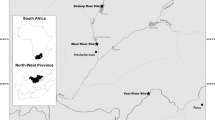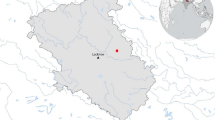Summary
The spotted snakehead, Channa punctata Bloch, 1793, is a locally important fish species commonly consumed by the natives in the state of Manipur, Northeast India. The fish host C. punctata from Lamphel area revealed a diplostomid metacercarial infection. Morphologically, the recovered metacercaria was identified as a species of Posthodiplostomum Dubois, 1936. Molecular characterization using the ribosomal RNA genes (rDNA 18S, ITS2 and 28S regions) and the mitochondrial CO1 region supplements the identification. Molecular analysis revealed the metacercaria to be closely related to Posthodiplostomum sp. Japan isolate, with sequence similarity variation from 97.5–99.7 % while considering for the three rDNA markers. The secondary structure of the ITS2 region further corroborated these results; the typical four-helix model, when compared to the taxon from Japan, showed differences only in twelve bases (with seven transitions and five transversions). In phylogenetic analysis also, the metacercaria claded with the genus Posthodiplostomum, coming closer to the Japanese isolate, thus supplementing the morphological identification of the metacercaria.
Similar content being viewed by others
References
Athokpam, V. D., Tandon, V. (2013): A survey of metacercarial infections in commonly edible fish and crab hosts prevailing in Manipur, Northeast India. J. Parasit. Dis., DOI 10.1007/s12639-013-0360-z
Avault, J. W., Smitherman, R. O. (1965): Experimental host specificity of Posthodiplostomum minimum. Exp. Parasitol., 17: 268–270. DOI: 10.1016/0014-4894(65)90069-X
Bowles, J., Blair, D., Mcmanus, D. P. (1995): A molecular phylogeny of the human schistosomes. Mol. Phylogenet. Evol., 4: 103–109
Bowles, J., Hope, M., Tiu, W.U., Liu, X., Mcmanus, D. P. (1993): Nuclear and mitochondrial genetic markers highly conserved between Chinese and Philippine Schistosoma japonicum. Acta. Trop., 55: 217–229
Chubb, J. C. (1977): Seasonal occurrence of helminthes in freshwater fishes. Part I. Monogenea. Adv. Parasitol., 15: 133–199
Coleman, A. W. (2003): ITS2 is a double-edged tool for eukaryote evolutionary comparisons. Trends Genet., 19: 370–375. DOI: 10.1016/S0168-9525 (03)00118-5
Coleman, A. W. (2007): Pan-eukaryote ITS2 homologies revealed by RNA secondary structure. Nucleic Acids Res., 35: 3322–3329. DOI: 10.1093/nar/gkm233
Colley, F. C., Olson, A. C. J. (1963): Posthodiplostomum minimum (Trematoda: Diplostomidae) in fishes of Lower Otay Reservoir, San Diego County, California. J. Parasitol., 49: 148
Criscione, C. D., Poulin, R., Blouin, M. S. (2005): Molecular ecology of parasites: elucidating ecological and microevolutionary processes. Mol. Ecol., 14: 2247–2257. DOI: 10.1111/j.1365-294X.2005.02587.x
Diez, B., Pedros-alio, C., Massana, R. (2001): Study of genetic diversity of eukaryotic picoplankton in different oceanic regions by small-subunit rRNA gene cloning and sequencing. Appl. Environ. Microbiol., 67: 2932–2941. DOI: 10.1128/AEM.67.7.2932-2941.2001
Dönges, J. (1964): The life cycle of Posthodiplostomum cuticola (v. Nordmann, 1832) Dubois, 1936 (Trematoda, Diplostomatidae). Z. Parasitenkd., 24: 169–248
Dönges, J. (1969): Entwicklungs- und lebensdauer von metacercariaen. Z. Parasitenkd., 31: 340–366
Galazzo, D. E., Dayanandan, S., Marcogliese, D. J., Mclaughlin, J. D. (2002): Molecular systematics of some North American species of Diplostomum (Digenea) based on rDNA-sequence data and comparisons with European congeners. Can. J. Zool., 30: 2207–2217. DOI: 10.1139/Z02-198
Ghatani, S., Shylla, J. A., Tandon, V., Chatterjee, A., Roy, B. (2012): Molecular characterization of pouched amphistome parasites (Trematoda: Gastrothylacidae) using ribosomal ITS2 sequence and secondary structures. J. Helminthol., 86: 117–124. DOI: 10.1017/S0022149X11000125
Graczyk, T. (1991): Variability of metacercariae of Diplostomum spathaceum (Rudolphi, 1819). (Trematoda, Diplostomidae). Acta. Parasitol., 36: 135–139
Hall, T. A. (1999): BioEdit: a user-friendly biological sequence alignment editor and analysis program for Windows 95/98/NT. Nucleic Acids Symposium Series, 41: 95–98
Huelsenbeck, J. P., Ronquist, F. (2001): MRBAYES: Bayesian inference of phylogeny. Bioinformatics, 17: 754–755. DOI: 10.1093/bioinformatics/17.8.754
Ishii, S. (1951): Diplostomiasis of crucian carp in Japan. Dbutsugaku zasshi, 27: 410–411 (in Japanese)
Jalali, B. (1998): The parasites and parasitic diseases of freshwater fishes of Iran. Iranian Fisheries Company Publications, pp: 563
Joseph, N., Krauskopf, E., Vera, M. I., Michot, B. (1999): Ribosomal internal transcribed spacer 2 (ITS2) exhibits a common core of secondary structure in vertebrates and yeast. Nucleic Acids Res., 27: 4533–4540. DOI: 10.1093/nar/27.23.4533
Karimian, E., Ghorbani, R., Hajimoradlou, A. (2013): First occurrence and intensity of Posthodiplostomum cuticola (Nordmann, 1832) (Digenea; Diplostomatidae) metacercariae in monkey goby (Neogobius pallasi Berg, 1916) in the Zarringol stream, Golestan Province, Iran. Global Veterinaria, 10 (5): 505–510. DOI: 10.5829/idosi.gv.2013.10.5.20413
Keller, A., Forster, F., Muller, T., Dandekar, T., Schultz, J., Wolf, M. (2010): Including RNA secondary structures improves accuracy and robustness in reconstruction of phylogenetic trees. Biol. Direct, 5: 4. DOI: 10.1186/1745-6150-5-4
Keller, A., Schleicher, T., Schultz, J., MÜLLER, T., Dandekar, T., Wolf, M. (2009): 5.8S-28S rRNA interaction and HMM-based ITS2 annotation. Gene, 430: 50–57. DOI: 10.1016/j.gene.2008.10.012
Kurochkin, Y. V., Biserova, L. I. (1996): The etiology and diagnostics of ‘black-spot disease’ in fish. Parazitologiya, 30: 117–125
Lane, R. L., Morris, J. E. (2000): Biology, prevention, and effects of common grubs (digenetic trematodes) in freshwater fish. Tech. Bull. Series (Iowa State Univ), 115: 1–6
Lewis, W. M., Nickum, J. (1964): The effect of Posthodiplostomum minimum upon the body weight of the bluegill. Prog. Fish-Cult., 26(3): 121–123
Lucky, Z. (1970): Pathological changes with posthodiplostomosis of fish fry. Acta. Vet. Brno., [Suppl]. 1: 51–66
Mcmanus, D. P., Bowles, J. (1996): Molecular genetics approaches to parasite identification: their value in diagnostic parasitology and systematics. Int. J. Parasitol., 26: 687–104. DOI: 10.1016/0020-7519(96)82612-9
Morgan, J. A. T., Blair, D. (1998): Trematode and monogenean rRNA ITS2 secondary structures support a fourdomain model. J. Mol. Evol., 47: 406–419
Nagasawa, K., Awakura, T., Urawa, S. (1989): A checklist and bibliography of parasites of freshwater fishes of Hokkaido. Sci. Rep. Hokkaido Fish Hatch, 44: 1–49
Nguyen, T. C., Li, Y-C., Makouloutou, P., Jimenez, L. A., Sato, H. (2012): Posthodiplostomum sp. metacercariae in the trunk muscle of Northern snakeheads (Channa argus) from the Fushinogawa River, Yamaguchi, Japan. J. Vet. Med. Sci., 74 (10): 1367–1372. DOI: 10.1292/jvms.12-0025
Niewiadomska, K. (2001): Family Diplostomidae Poirier, 1886. In: Gibson, D. I., Jones, A., Bray, R. A. (Eds) Keys to the Trematoda, Volume 1. London, CABI Publishing and The Natural History Museum, pp. 167–196
Niewiadomska, K., Laskowski, Z. (2002): Systematic relationships among six species of Diplostomum Nordmarm, 1832 (Digenea) based on morphological and molecular data. Acta. Parasitol., 47: 20–28
Niewiadomska, K., Szymański, S. (1991): Host-induced variability of Diplostomum paracaudum (Lies, 1959) metacercariae (Digenea). Acta. Parasitol. Pol., 36: 11–17
Nolan, M. J., Cribb, T. H. (2005): The use and implications of ribosomal DNA sequencing for the discrimination of digenean species. Adv. Parasitol., 60: 102–163. DOI: 10.1016/S0065-308X(05)60002-4
Olson, P. D., Tkach, V. V. (2005): Advances and trends in the molecular systematics of the parasitic platyhelminthes. Adv. Parasitol., 60: 165–243. DOI: 10.1016/S0065-308X(05)60003-6
Ondračková, M., Jurajda, P., Gelnar, M. (2002): The distribution of Posthodiplostomum cuticola metacercariae in young-of-the-year cyprinid fishes. J. Fish Biol., 60: 1355–1357. DOI: 10.1111/j.1095-8649.2002.tb01731.x
Ondračková, M., Reichard, M., Jurajda, P., Gelnar, M. (2004a): Seasonal dynamics of Posthodiplostomum cuticola (Digenea, Diplostomatidae) metacercariae and parasite-enhanced growth of juvenile host fish. Parasitol. Res., 93: 131–136. DOI: 10.1007/s00436-004-1123-7
Ondračková, M., Šimková, A., Gelnar, M., Jurajda, P. (2004b): Posthodiplostomum cuticola (Digenea: Diplostomatidae) in intermediate fish hosts: factors contributing to the parasite infection and prey selection by the definitive bird host. Parasitology, 129: 761–770
Rolbiecki, L. (2004): Distribution of Posthodiplostomum cuticola (Nordmann, 1832) (Digenea; Diplostomidae) metacercariae in cyprinids of the Vistula lagoon, Poland. Archives of Polish Fisheries, 12(1): 93–98
Schäpperclaus, W. M. (1990): Fischkrankheiten. Academie Verlag, Berlin. 5. Auflage
Schultz, J., Maisel, S., Gerlach, D., Müller, T., Wolf, M. (2005): A common core of secondary structure of the internal transcribed spacer 2 (ITS2) throughout the Eukaryota. RNA, 11: 361–364. DOI: 10.1261/rna.7204505
Schultz, J., Müller, T., Actziger, M., Seibel, P. N., Dandekar, T., Wolf, M. (2006): The internal transcribed spacer 2 database — a web server for (not only) low level phylogenetic analyses. Nucleic Acids Res., 34: 704–707. DOI: 10.1093/nar/gkl129
Seibel, P. N., Müller, T., Dandekar, T., Schultz, J., Wolf, M. (2006): 4SALE — a tool for synchronous RNA sequence and secondary structure alignment and editing. BMC Bioinformatics, 7: 498. DOI: 10.1186/1471-2105-7-498
Selig, C., Wolf, M., Müller, T., Dandekar, T., Schultz, J. (2008): The ITS2 Database II: homology modelling RNA structure for molecular systematics. Nucleic Acids Res., 36: D377–D380. DOI: 10.1093/nar/gkm827
Shukhgalter, O., Chukalova, N. (2002): An investigation of “black spot” disease of bream (Abramis brama) from Curonian Lagoon, south-east Baltic Sea. Bull. Eur. Assoc. Fish. Pathol., 22: 218–221
Shylla, J. A., Ghatani, S., Chatterjee, A., Tandon, V. (2011): Secondary structure analysis of ITS2 in the rDNA of three Indian paramphistomid species found in local livestock. Parasitol. Res., 108: 1027–1032. DOI: 10.1007/s00436-010-2148-8
Skrjabin, K. I. (1964): Trematodes of animals and man: Essentials of trematodology, Vol. XVII, Israel Program for Scientific Translations, Jerusalem (translated in English by Birron, A. and Cole, Z. S.)
Sonin, M. D. (1986): Key to the trematode parasites of fish-eating birds in Palearctic Region, Nauka, Moscow
Stanevičiūtė, G., Petkevičiūtė, R., Kiselienė, V. (1998): Karyological analysis of two species of genus Posthodiplostomum Dubois, 1936 (Trematoda: Diplostomidae) with remarks on the karyological evolution of Diplostomidae. Acta. Zool. Lit., 8(1): 41–47. DOI: 10.1080/13921657.1998.10541437
Tandon, V., Prasad, P. K., Chatterjee, A., Bhutia, P. T. (2007): Surface fine topography and PCR-based determination of metacercaria of Paragonimus sp. from edible crabs in Arunachal Pradesh, Northeast India. Parasitol. Res., 102: 21–28. DOI: 10.1007/s00436-007-0715-4
Thompson, R. C. A., Zarlenga, D. S., La-rosa, G., Pozio, E., Rosenthal, B., Bandi, C., Mortarino, M., Casiraghi, M., Genchi, C., Gasser, R. B., Hu, M., Chilton, N. B., Matthews, J. B., Hodgkinson, J. E. (2004): Advances in the diagnosis and systematics of parasites of veterinary importance: new and exciting prospects. In: Gasser, R. B, Zarlenga, D. S. (Eds) Molecular systematics and diagnosis. Vet. Parasitol., 125: 69–72
Tkach, V. V., Pawlowski, J., Mariaux, J. (2000): Phylogenetic analysis of the suborder Plagiorchiata (Platyhelminthes, Digenea) based on partial lsrDNA sequences. Int. J. Parasitol., 30: 83–93. DOI: 10.1016/S0020-7519(99)00163-0
Toyooka, R., Okada, K. (1954): Studies on the development of two diplostomatid metacercariae, found in Oryzias latipes, a freshwater fish. J Gakugei Tokushima Univ, 4: 55–64
Vytautas, R., ÈEslovas, B. (2009): Distribution, prevalence and intensity of roach (Rutilus rutilus (Linnaeus, 1758)) parasites in inland waters of Lithuania in 2005-2008. Acta. Zool. Lituanica, 19(2): 99–108. DOI: 10.2478/v10043-009-0017-4
Yamaguti, S. (1971): Synopsis of digenetic trematodes of vertebrates, Vol. I, II. Keigaku Publishing Co., Tokyo
Zhao, G. H., Li, J., Mo, X. H., Li, X. Y., Lin, R. Q., Zou, F. C., Weng, Y. B., Song H. Q., Zhu, X. Q. (2012): The second transcribed spacer rDNA sequence: an effective genetic marker for inter-species phylogenetic analysis of trematodes in the order Strigeata. Parasitol. Res., 111: 1467–1472. DOI: 10.1007/s00436-012-2981-z
Zrnčić, S., Oraić, D., Mihaljević, Z., Ćaleta, M., Zanella, D., Jelić, D., Jelić, M. (2009): First observation of Posthodiplostomum cuticola (Nordmann, 1832) metacercariae in cypriniformes from Croatia. Helminthologia, 46: 112–116. DOI: 10.2478/s11687-009-0022-y
Zuker, M. (2003): Mfold web server for nucleic acid folding and hybridization prediction. Nucleic Acids Res., 31: 3406–3415. DOI: 10.1093/nar/gkg595
Author information
Authors and Affiliations
Corresponding author
About this article
Cite this article
Athokpam, V.D., Tandon, V. Morphological and molecular characterization of Posthodiplostomum sp. (Digenea: Diplostomidae) metacercaria in the muscles of snakeheads (Channa punctata) from Manipur, India. Helminthologia 51, 141–152 (2014). https://doi.org/10.2478/s11687-014-0221-z
Received:
Accepted:
Published:
Issue Date:
DOI: https://doi.org/10.2478/s11687-014-0221-z




